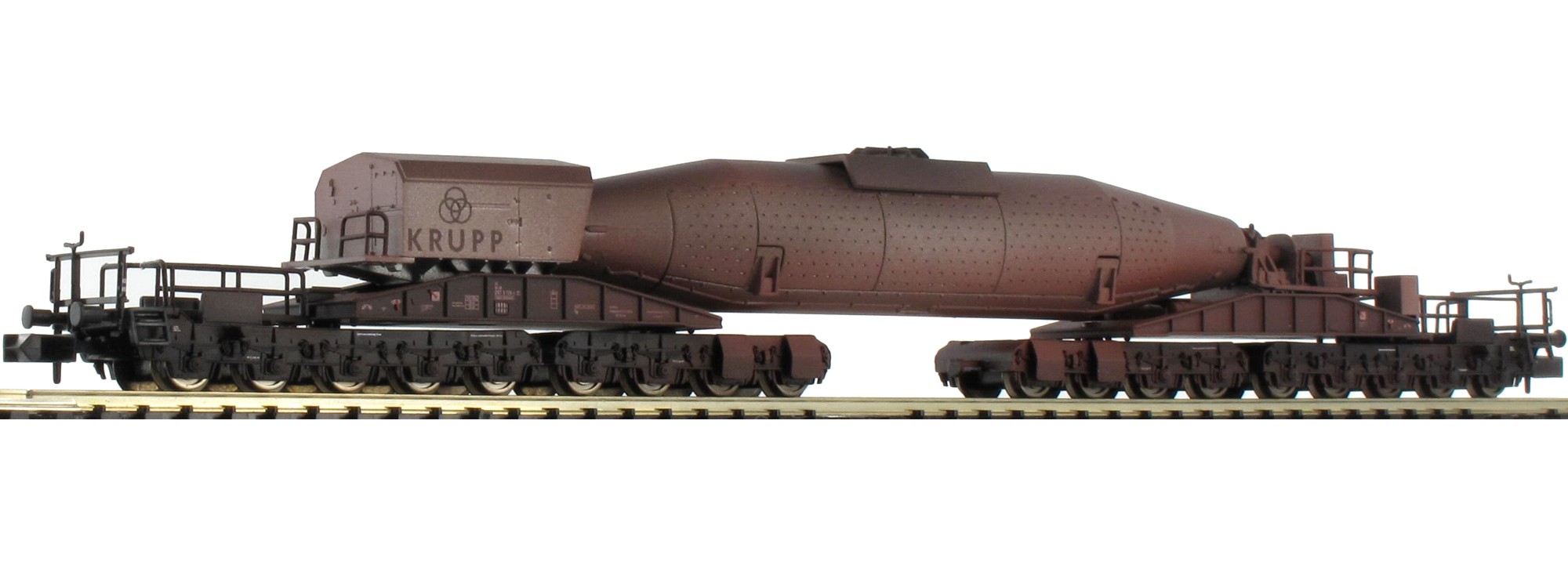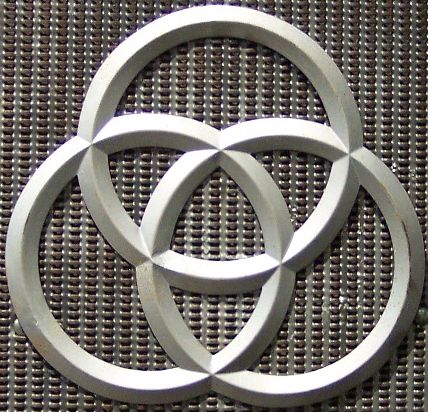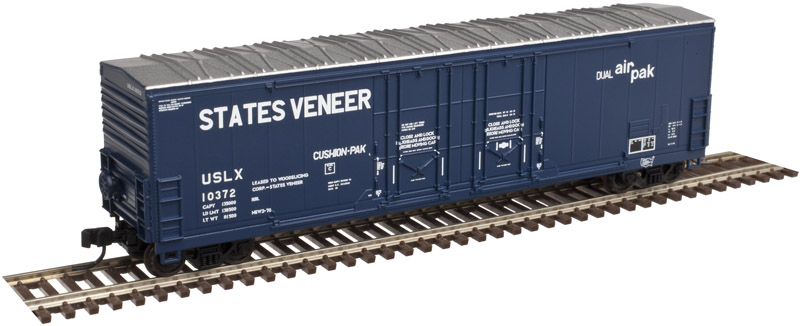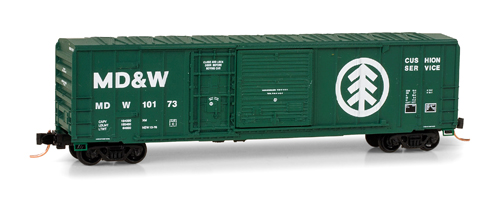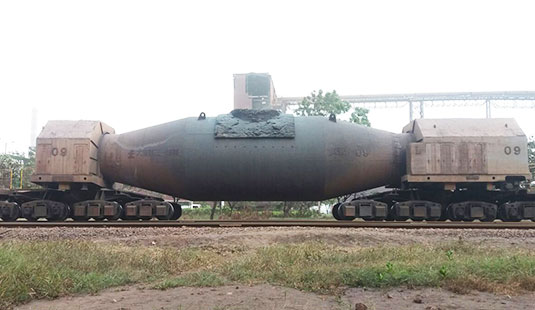Specific Item Information: Prototype: Privately owned car for transporting molten crude iron, used on the German Federal Railroad. Built starting in 1967. Model: The container is constructed of metal. The car has a close coupler mechanism. The container can be tipped to both sides. The car is weathered. Length over the buffers 212 mm / 8-3/8".
Highlights: Weathered version. New car number.
Highlights: Weathered version. New car number.
Prototype History: The main product of a blast furnace is molten crude iron. It is transported in torpedo ladle cars for additional processing in a steel plant. The cars can be carried on 18-axles with an authorized total weight of 360 metric tons. The interior of the container is bricked up to be fireproof in order that the 1,350° Celsius / 2,462° Fahrenheit hot load does not cool down on the one hand and to prevent the container from melting. Three to four of these cars often run in a train. Two-axle empty freight cars are coupled between them to keep from exceeding the permissible load on railroad bridges.
Road Name History: The Krupp family (see pronunciation), a prominent 400-year-old German dynasty from Essen, have become famous for their production of steel, artillery, ammunition, and other armaments. The family business, known as Friedrich Krupp AG, was the largest company in Europe at the beginning of the 20th century. It was important to weapons development and production in both world wars. One of the most powerful dynasties in European history, for 400 years Krupp flourished as the premier weapons manufacturer for Germany. From the Thirty Years' War until the end of the Second World War, they produced everything from battleships, U-boats, tanks, howitzers, guns, utilities, and hundreds of other commodities.
The dynasty began in 1587 when a trader named Arndt Krupp moved to Essen and joined the merchants guild. He then began buying vacated real estate from families who fled the city due to the Black Death and became one of the richest men in the city. Over the next three centuries his descendants began producing small guns during the Thirty Years' War and over time gradually acquired fulling mills, coal mines, and an iron forge. During the Napoleonic Wars, Friedrich Krupp founded the Gusstahlfabrik (Cast Steel Works) and began producing smelted steel in 1816, turning the company into a major industrial power. The foundations were laid for the steel empire that would come to dominate the world for nearly a century under his son Alfred. Krupp became the arms manufacturer for the Kingdom of Prussia in 1859 and later the German Empire.
Krupp was also a revolutionary company that paved the way for workers rights. Alfred pioneered a system in which if the worker pledged loyalty to the company, he would be offered an unprecedented amount of benefits and social programs including on site technical and manual training, accidental, sickness, and life insurance, housing (sometimes free), recreational facilities, parks, schools, bath houses, and department stores. Widows and orphans were guaranteed pay if their husbands and/or fathers were killed.
The company also produced steel used to build railroads in the United States, capped the Chrysler Building in 1929, and was the first to travel to the bottom of the Mariana Trench. During the Third Reich, Krupp supported Adolf Hitler and the use of forced labour. After the war Krupp was rebuilt from scratch and again became one of the wealthiest companies in Europe. However a recession in 1967 caused the company severe profit loss. In 1999 the Krupp firm merged with Thyssen AG to form ThyssenKrupp AG, a large industrial conglomerate.
Historically the Krupp business has been controversial in its association with wars in Europe. As a major weapons supplier to multiple sides in various conflicts, the Krupps at times received blame for the wars themselves or the degree of carnage that ensued.
From Wikipedia
The dynasty began in 1587 when a trader named Arndt Krupp moved to Essen and joined the merchants guild. He then began buying vacated real estate from families who fled the city due to the Black Death and became one of the richest men in the city. Over the next three centuries his descendants began producing small guns during the Thirty Years' War and over time gradually acquired fulling mills, coal mines, and an iron forge. During the Napoleonic Wars, Friedrich Krupp founded the Gusstahlfabrik (Cast Steel Works) and began producing smelted steel in 1816, turning the company into a major industrial power. The foundations were laid for the steel empire that would come to dominate the world for nearly a century under his son Alfred. Krupp became the arms manufacturer for the Kingdom of Prussia in 1859 and later the German Empire.
Krupp was also a revolutionary company that paved the way for workers rights. Alfred pioneered a system in which if the worker pledged loyalty to the company, he would be offered an unprecedented amount of benefits and social programs including on site technical and manual training, accidental, sickness, and life insurance, housing (sometimes free), recreational facilities, parks, schools, bath houses, and department stores. Widows and orphans were guaranteed pay if their husbands and/or fathers were killed.
The company also produced steel used to build railroads in the United States, capped the Chrysler Building in 1929, and was the first to travel to the bottom of the Mariana Trench. During the Third Reich, Krupp supported Adolf Hitler and the use of forced labour. After the war Krupp was rebuilt from scratch and again became one of the wealthiest companies in Europe. However a recession in 1967 caused the company severe profit loss. In 1999 the Krupp firm merged with Thyssen AG to form ThyssenKrupp AG, a large industrial conglomerate.
Historically the Krupp business has been controversial in its association with wars in Europe. As a major weapons supplier to multiple sides in various conflicts, the Krupps at times received blame for the wars themselves or the degree of carnage that ensued.
From Wikipedia
Brand/Importer Information: Trix is a German company that originally made Trix metal construction sets. one of its co-founders was Stephan Bing, the son of the pioneer toy-maker industrialist Ignaz Bing. In 1935 the company began producing the electrically powered model trains that it became famous for, under the Trix Express label. Prior to the outbreak of World War II the Trix company produced a small range of fairly unrealistic AC powered three rail models running at 14 volts.
N gauge models under the Minitrix brand were made from the late 1960s mostly of European prototypes (German and British primarily). North American prototypes were also manufactured and marketed under the Aurora "Postage Stamp" brand; later these items were sold under the American Tortoise, Model Power and Con-Cor brands. Trix sometimes utilized North American consultants to aid in the design of this portion of the product line. The "Hornby Minitrix' brand was used in the 1980s for a short lived range of British outline models using the earlier product tooling.
Trix's owner in the 1980s and 1990s was Mangold, which went bankrupt in the late 1990s and Märklin purchased the assets in January 1997. In part, this purchase was a reflection of Märklin's need for added production capacity; Trix had been manufacturing certain items for Märklin in previous years. The purchase was also in response to the earlier purchase of the Karl Arnold company by the Italian company Rivarossi; Märklin were very keen to take over Trix market share in 2-rail H0 and especially Minitrix, until then Märklin had not marketed N gauge models. In 2003, Märklin introduced its first N gauge models under the well established Minitrix brand. A number Märklin H0 scale three-rail AC locomotives have also been introduced in two-rail DC versions under the Trix logo and many models are shared between the two brands.
From Wikipedia
N gauge models under the Minitrix brand were made from the late 1960s mostly of European prototypes (German and British primarily). North American prototypes were also manufactured and marketed under the Aurora "Postage Stamp" brand; later these items were sold under the American Tortoise, Model Power and Con-Cor brands. Trix sometimes utilized North American consultants to aid in the design of this portion of the product line. The "Hornby Minitrix' brand was used in the 1980s for a short lived range of British outline models using the earlier product tooling.
Trix's owner in the 1980s and 1990s was Mangold, which went bankrupt in the late 1990s and Märklin purchased the assets in January 1997. In part, this purchase was a reflection of Märklin's need for added production capacity; Trix had been manufacturing certain items for Märklin in previous years. The purchase was also in response to the earlier purchase of the Karl Arnold company by the Italian company Rivarossi; Märklin were very keen to take over Trix market share in 2-rail H0 and especially Minitrix, until then Märklin had not marketed N gauge models. In 2003, Märklin introduced its first N gauge models under the well established Minitrix brand. A number Märklin H0 scale three-rail AC locomotives have also been introduced in two-rail DC versions under the Trix logo and many models are shared between the two brands.
From Wikipedia
Item created by: gdm on 2019-05-21 09:37:12
If you see errors or missing data in this entry, please feel free to log in and edit it. Anyone with a Gmail account can log in instantly.
If you see errors or missing data in this entry, please feel free to log in and edit it. Anyone with a Gmail account can log in instantly.


